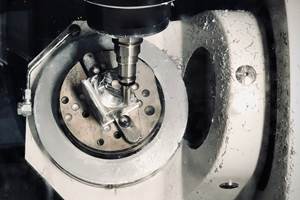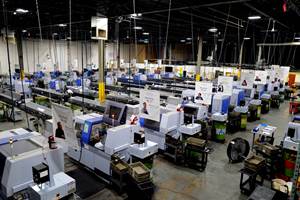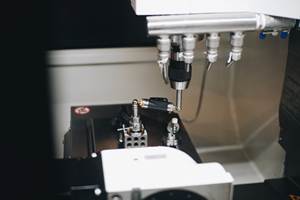Mazak Turning Machines Feature Three Turrets for High-Volume Production
The HQR-200/3 and HQR-250/3 NEO machines both have two spindles and three turrets — two upper and one lower — for “done-in-one” part processing and high-volume throughput in single setups.
Share






Mazak’s HQR-NEO Series features a three-turret machine configuration, offering more tools to handle feature-rich part applications and enabling shops to achieve a 50/50 cycle-time balance between the two turning spindles for optimum throughput.
As the first in the series, the HQR-200/3 and HQR-250/3 NEO machines both have two spindles and three turrets — two upper and one lower — for “done-in-one” part processing and high-volume throughput in single setups. The drum-style turrets provide 12 or 16 tool positions and rotary tool capability. In some instances, the machine can have up to 36 tools at 12 tools per station or 16 tools per station for a total of 48 tools, and all those stations can be live. Plus, with such turrets, tool change times are much faster as compared to machines with carousel-type tool changers.
In terms of bar size capacity, the HQR NEO machines are the next step up from Swiss-style turning machines. Main spindles on the HQR 200/3 and 250/3 NEOs offer 4"-diameter bar stock capacity, while the second spindles are capable of processing bar diameters up to 2.5" (76-mm bore). Both turning spindles on the HQR 200/3 NEO deliver maximum speeds of 5,000 rpm, while upper turrets and the lower one provide 6,000 rpm rotating tool speed. The main turning spindle on the HQR 250/3 NEO runs at a maximum of 4,000 rpm and the second turning spindle at a 5,000-rpm maximum.
On the HQR NEO machines, the two upper turrets are each dedicated to one turning spindle, while the third lower turret can work at either the left or right-side spindles. As such, the third turret allows shops to achieve more of a cycle time balance between operations at the first and second turning spindles for shortening overall part cycle times.
Specifically, for the HQR-200/3 NEO and HQR-250/3 NEO, Mazak developed its Mazatrol SmoothG3 control to support three-turret machine functionality. The control gives users a clear, specific and concise display of the turrets for programming and operational ease of use and to ensure process security. The Mazatrol SmoothG3 also features Mazak’s Ai Thermal Shield technology, which uses machine learning and modeling to compensate instantly for changes in machine and ambient temperature over the course of operation.
To control chip generation and prevent problems such as bird nesting, Mazak developed what it refers to as an oscillating cutting function for the HQR-200/3 and 250/3 NEOs. The function oscillates the cutting tool, which breaks up chips into smaller, more manageable sizes for evacuating them out of the machine as quickly as possible. The HQR-200/3 and 250/3 NEO machines also feature an end-of-bar remanent control function, which activates a machine disposal bucket so that the remanent is quickly ejected from the work envelope, goes down a shoot and exits to left side the machine. This keeps production moving smoothly to the next new bar.
Other optional features for the HQR NEO machines include Mazak’s Tool Eye and the company’s Super Flow high-pressure coolant system. The Tool Eye for fast and easy tool set up is installed at two locations — on the main spindle side and the second spindle side. While the first spindle side is basically a normal tool eye unit, the second spindle side is a mechanism that swings down from above to the second spindle due to the layout of the tool post.
A Mazak Super Flow high-pressure coolant unit enables shops to change machine coolant pressure to seven different levels through M-code programming commands. For the three-turret machines, three Super Flow units are used to enable the pressure change function. However, if a shop does not require different pressure levels on each turret, one can apply only a single Super Flow unit.
Related Content
How to Successfully Adopt Five-Axis Machining
While there are many changes to adopt when moving to five-axis, they all compliment the overall goal of better parts through less operations.
Read MoreInside the Premium Machine Shop Making Fasteners
AMPG can’t help but take risks — its management doesn’t know how to run machines. But these risks have enabled it to become a runaway success in its market.
Read MoreBallbar Testing Benefits Low-Volume Manufacturing
Thanks to ballbar testing with a Renishaw QC20-W, the Autodesk Technology Centers now have more confidence in their machine tools.
Read MoreHow to Determine the Currently Active Work Offset Number
Determining the currently active work offset number is practical when the program zero point is changing between workpieces in a production run.
Read MoreRead Next
Machine Shop MBA
Making Chips and 91±¬ÁĎÍř are teaming up for a new podcast series called Machine Shop MBA—designed to help manufacturers measure their success against the industry’s best. Through the lens of the 91±¬ÁĎÍř benchmarking program, the series explores the KPIs that set high-performing shops apart, from machine utilization and first-pass yield to employee engagement and revenue per employee.
Read MoreAMRs Are Moving Into Manufacturing: 4 Considerations for Implementation
AMRs can provide a flexible, easy-to-use automation platform so long as manufacturers choose a suitable task and prepare their facilities.
Read More




















